The SEMRush SEO Content Template is an AI-assisted content marketing tool that enables marketers to create SEO-optimized articles every single time. It is part of the SEMRush Content Marketing Toolkit.
Does it sound too good to be true? Find out for yourself.
Here’s what you’ll learn in this guide:
- What is the SEO Content Template (SCT)
- What it can do for you and why it’s important
- What are some use cases for it
In the interest of transparency, this post may contain affiliate links to the tools mentioned. At no additional cost to you, if you click through and decide to purchase, I will earn a commission. Regardless, I only recommend products I use and believe will add value to you.
What is the SEO Content Template?
Today, content is what separates you from your competition. If you want to succeed, you need to consistently create high-quality content so that it ranks high on Google. If you don’t, then you’ll have to rely on unsustainable and unreliable channels such as paid advertising and social media.
SEMRush’s SEO Content Template helps you create blog posts or pages that are optimized for search engines. It eliminates the guesswork. It helps speed up the research process. This way, you don’t get stuck with planning. You get to spend more time with the execution.
As mentioned above, it’s an AI-assisted content marketing tool. Here’s how it works:
- You enter a keyword or two that you want to target
- It gathers information on the top 10 pages ranking on Google
- Gives you recommendations on what you should include in your article
It’s as simple as that.
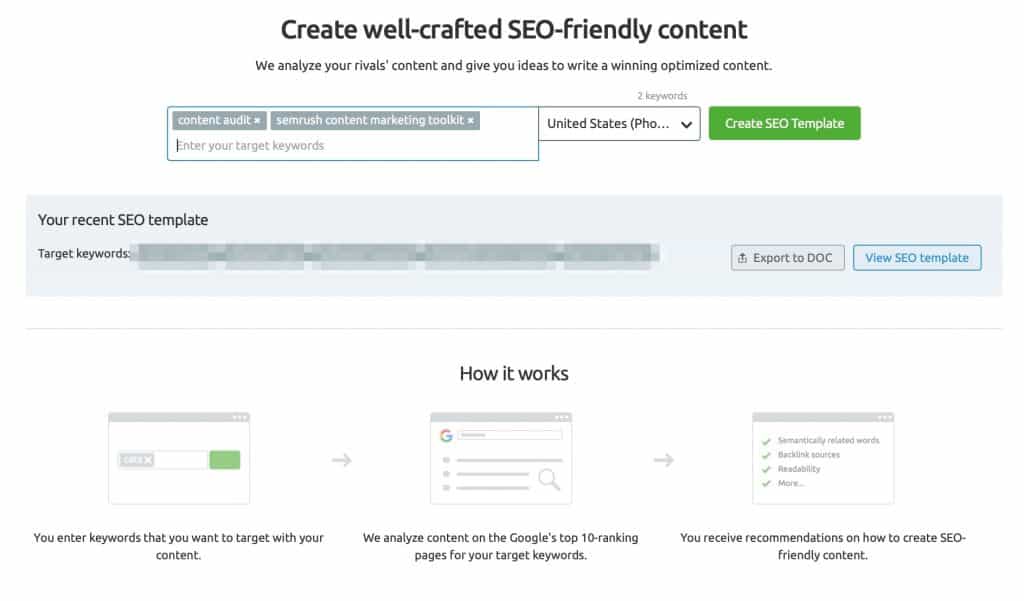
Parts of the SEO Content Template and Why It’s Important
The SEO Content Template, as the name suggests, creates a template for you that you can use to write articles that are optimized for search engines. It’s composed of four main parts.
1. Target Keyword(s) and Top 10 Pages on Google
This is the first part that you’ll see in the SEO Content Template.
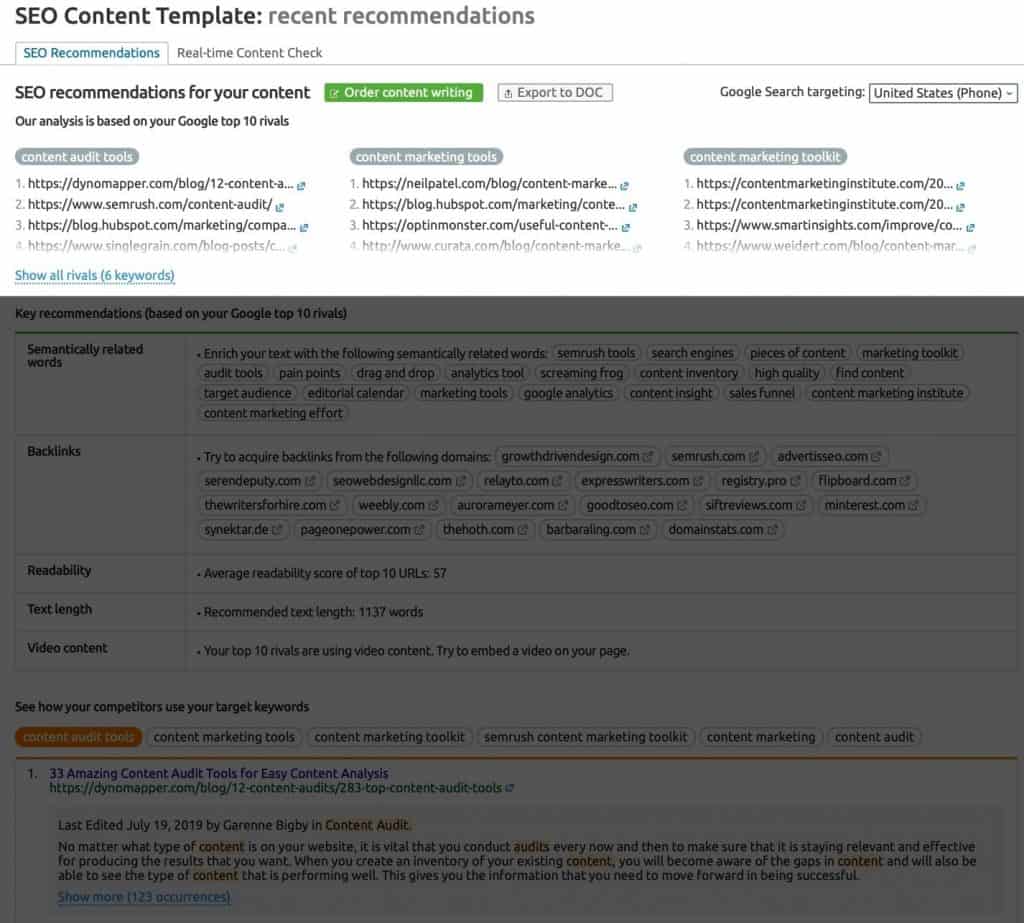
Depending on the number of keywords you’re trying to target (you can add up to 30 in one SCT), it will list who the top 10 competitors are on Google. Of course, I recommend only targeting 1-2 main keywords here. Too many and you’ll end up with recommendations all over the place.
Why Is This Important?
The first benefit you’ll get is the SCT speeds up your research process. As mentioned earlier, you get to spend more time crafting your article instead of researching.
I’m not saying proper keyword research is not important. It is. But at the end of the day, you don’t get results from research. Results only come from the outside. And that means publishing your article or blog post.
The SEO Content Template analyzes the top 10 pages you need to beat and gives you the recommendations on how to do so (which I cover in the next section). But what makes this important is you get the lay of the land.
Because there is so much content out there, you absolutely cannot think and act in isolation. What that means you there is a lot of competition. And you cannot simply create your own rules. Unless you are in a brand new niche and category, which for 99.99% of us, aren’t. Looking at what’s already ranking on search engines is a good place to start to know what users are searching for.
Every search engine wants to deliver the most accurate and timely information to its user—Google, Bing, Duck Duck Go, and everybody else. Even on social media sites, this is the behavior, from YouTube, to Instagram, to Tik Tok.
As a marketer, this is important to understand because they are already ranking for the search terms you are trying to rank for. What that means is they are already fulfilling the needs of the users. If you want to beat them, you have got to know what they are doing and what’s working for them.
That is the whole point of the SEO Content Template.
2. Key Recommendations
This section shows you what you need to do in order to, at least, be at par with your top 10 rivals on Google. If you want to be the first result on search engines, you have to beat every other web page in all aspects.
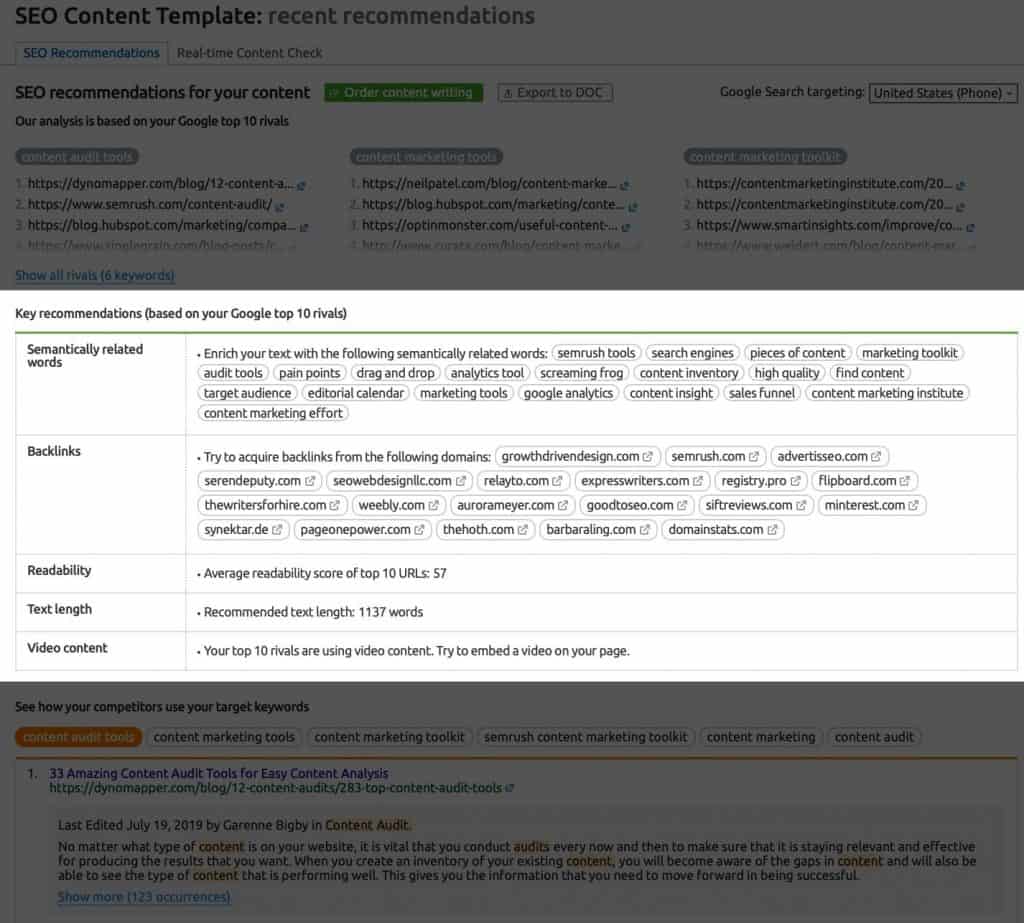
That also means you have to meet certain benchmarks. The SCT does this for you by giving you recommendations on the following aspects:
Semantically-Related Keywords
Semantics is a branch of linguistics concerned with deriving meaning from words. Semantically related keywords are simply words or phrases that are related to each other conceptually.
If you’re talking to someone about coffee and the topic of grinders come up, the person you’re talking to can easily understand that you are talking about coffee grinders. But computers aren’t that smart. In fact, if you search right now for “best grinders,” you’ll come up with results for the best weed grinders.
If this was you searching for something on Google, the result will be totally irrelevant. That’s where semantics come on. Semantically-related words help search engines understand what the page is all about.
And that’s what this list of semantically-related keywords is all about.
Instead of stuffing in your keyword over and over (like in the early days), you include these other variations.
Just think: when you search for “dogs”, you likely don’t want a page with the word “dogs” on it hundreds of times. With that in mind, algorithms assess if a page contains other relevant content beyond the keyword “dogs” — such as pictures of dogs, videos, or even a list of breeds.
—How Search Algorithms Work, Google
Here’s a nice graphic on Ahrefs that illustrates this.
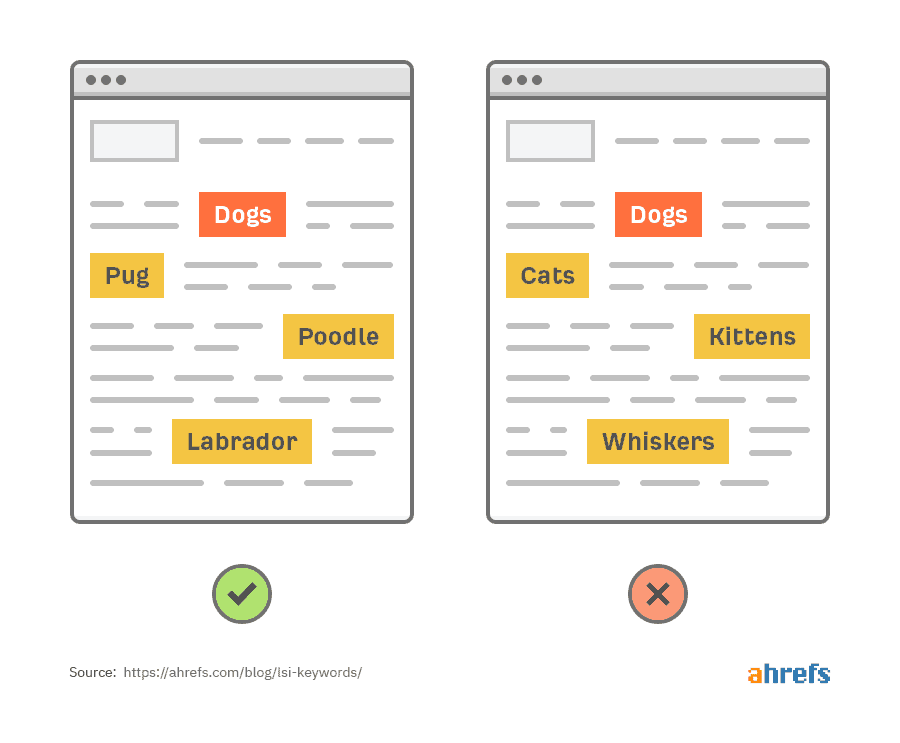
If you’re searching for information about dogs, you probably are looking for results that are closer to the one on the left, instead of the one on the right. The point is this list of semantically-related keywords can help your writing cover other topics that you might have missed.
Of course, you’d still apply some common sense into using these words in your article. These recommendations are only a starting point. If it’s not important or relevant, don’t use it.
Backlinks to Acquire
The SEO Content Template looks at all the backlinks for these top pages and finds you commonalities among them. The output is a list of domains you should try to get because the top 10 pages have links from these pages.
From my experience with this, it’s a hit-or-miss. I’d say 50% it gives you something concrete, while the other half it doesn’t make sense.
The main reason for the “failure” is that the links often come from irrelevant websites like directories. Remember, the golden rule about backlinks is to make sure they are relevant to your industry. If it’s not, don’t bother with them.
Readability
Readability is all about how easy it is to read your content. The metric used for calculating this is the Flesch–Kincaid readability test. It scores your article’s readability from 0 – 100.
The SEO Content Template looks at the top 10 results and gives you their average. This is the score you’d want to target.
I have run all my content through this and about half of them score “higher” on the scale—meaning it’s much easier to read than what’s currently out there.
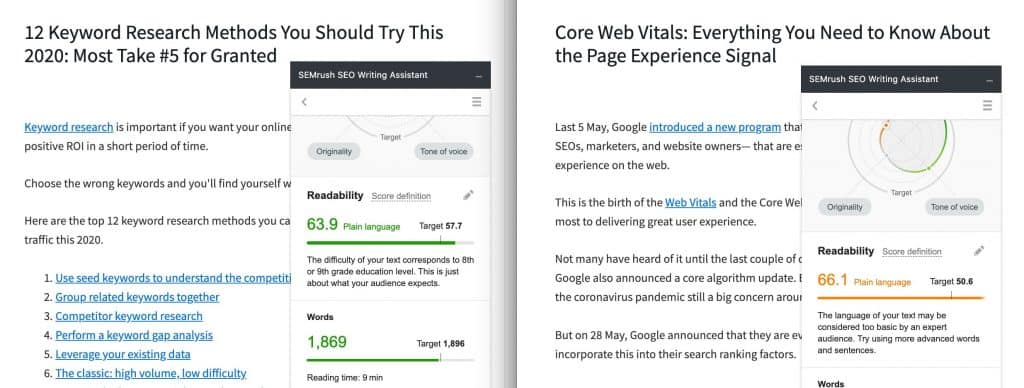
As you can see, in one article, I have green scores which mean everything is according to the SCT’s recommendations. But on the other one, my readability scores are higher (i.e. easier to read) than the rest. I’m okay with that. In fact, that’s what I’m trying to go for.
Text Length
This section averages the word count of the top ranking pages. It’s as simple as that. Depending on your goals, you can aim to meet the same number of words, go over it, or lower.
Other Recommendations
This last part sometimes doesn’t show up, but when it does, you’ve got to pay special attention.
For example, it might tell you that the top 10 rivals are using videos on their pages. If you don’t, then you’ll find it difficult to break through page one.
3. How Competitors Are Using the Keywords
This next section shows you how your competitors are using your target keywords. Personally, I don’t use it that much because I open up each article listed, read the post, and make mine better.
But this report is useful if you want to get a quick overview of how the search terms are being used. The report includes the title, URL, and highlights how the individual pages use the term.
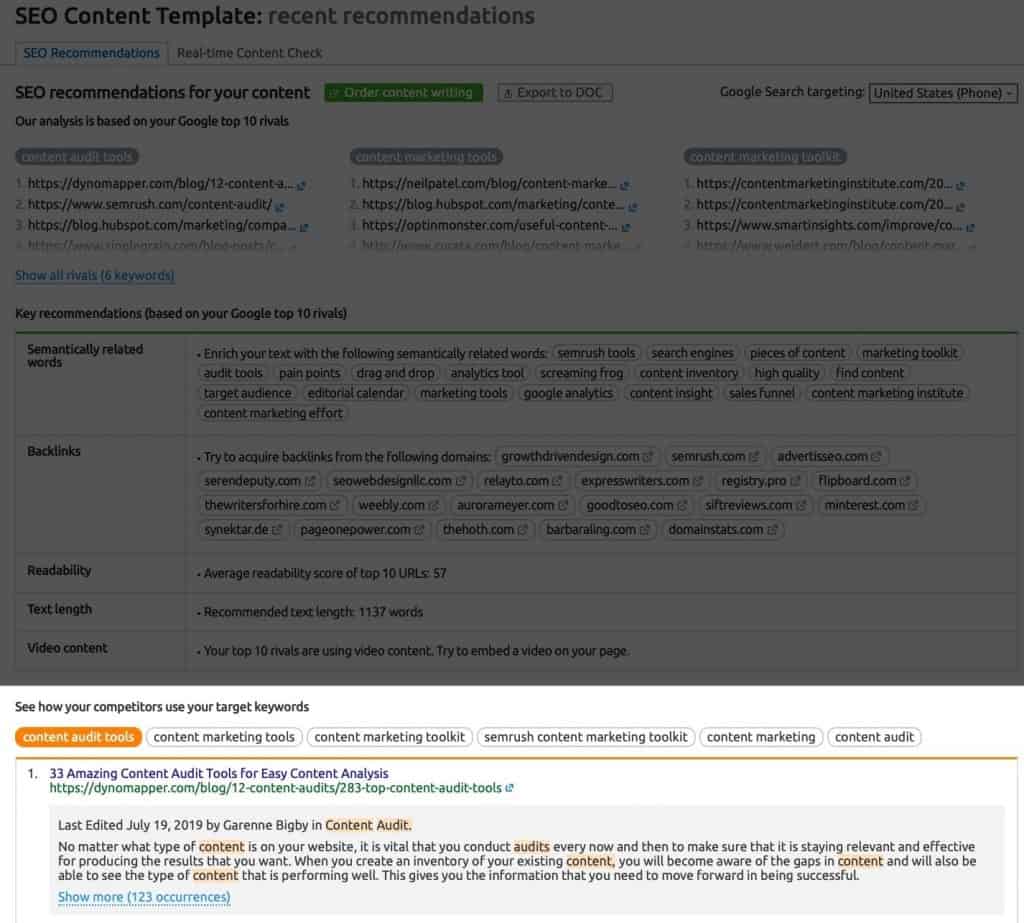
Why Is This Important?
This section gives you a high-level overview of how every page is using the keywords you’re targeting. More specifically, it highlights the first usage or occurrence of the term.
This can help you generate ideas or structure your messaging to make it similar or entirely different. Remember, these are the pages that are already ranking on the first page of Google. People are already reading these articles.
4. Basic Recommendations
The last section you’ll find in the SEO Content Template are your basic recommendations. If you’re already creating content frequently, this part will most likely be automatic for you.

These basic recommendations are reminders to include your main keyword in the page title, meta description, etc.
Why Is This Important?
This is important because it serves as a reminder. While we already know these basics, sometimes, we do tend to forget or overlook them.
Also, there are various use cases for the SEO Content Template. Some of the people using it aren’t experts. Some aren’t familiar with search engine optimization. Some are just writers or bloggers. So, having these reminders increases the chances that the users (you and me) will succeed in ranking on Google.
Sample Use Cases: What Can You Do with the SEO Content Template
There are various use cases for The SEO Content Template. It depends on where you are right now and what you do. An in-house marketer will have different needs from a marketing consultant working with multiple clients. An affiliate marketer will have different needs from a business owner.
Here are two main ways you can use the SEO Content Template.
- You use it as a guide to make SEO-friendly blog posts and keep your on-page SEO spot on; or,
- Use it to scale content marketing; or,
For the first use case, which I believe most people will use the SEMRush SEO Content Template for is to create SEO-friendly blog posts for their websites. I went through the basics of how you can do it here step-by-step.
The other use case is to scale your content marketing. At its core, you focus on content strategy then hand-off the SEO Content Templates to writers—whether in-house or outsourced.
Think about it. You can focus on handling the keyword research and tie everything together. Then, you rely on other writers to create the entire blog post. And since the SCT contains most of that the writers would need, you can easily scale your content marketing. With this strategy, you can pump out as many content as fast as possible.
Finally, you can download a Word document (.docx) version of the SEO Content Template then hand that off to your writers. Or, perhaps use it for offline writing.
Whatever the case, the SCT is a tool that can help you tremendously with creating content to rank on search engines.
Limitations of the SEO Content Template
The last part I want to go through are the limitations of SEMRush’s SEO Content Template.
The SCT is far from perfect. You have to apply common sense and not rely on it 100%. For example, I have created a bunch of these template and about 25% of the recommendations don’t apply.
For example, I’m writing this article after creating an SEO Content Template for the keyword “seo content template.” Since most of the top 10 rivals are pages from SEMRush itself, it uses the common keywords present on those pages.

The time and schedule doesn’t make sense. But, I can use the rest and, if in case you’re wondering, I did use these other words throughout this post.
Also, the SCT uses what SEMRush calls an SEO Ideas Units. Every keyword you add uses up one of these units. Every subscription plan has its own limits. I discussed more about this here.
Conclusion
The SEMRush SEO Content Template is a tool that I have been using since I started this website. I created an SCT for every single page and post on this website. It has helped me speed up the research process so I can focus on the execution aspect. That’s how I was able to churn out several posts in a short amount of time.
If you are serious about growing your organic traffic and creating SEO-optimized content, then you should definitely use this tool.
Have you used an AI-assisted tool to help you with content marketing? Or do you have any questions about the SEO Content Template?
I’d love to know.

One Response
good post